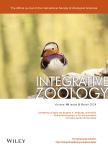Temperature determines the shift of thermal neutral zone and influences thermogenic capacity in striped hamsters
作者机构:College of Life and Environmental ScienceWenzhou UniversityWenzhouChina CAS Key Laboratory of Mountain Ecological Restoration and Bioresource UtilizationChengdu Institute of BiologyChinese Academy of SciencesChengduChina Zhejiang Provincial Key Laboratory for Water Environment and Marine Biological Resources ProtectionWenzhou UniversityWenzhouChina
出 版 物:《Integrative Zoology》 (整合动物学(英文版))
年 卷 期:2023年第18卷第2期
页 面:353-371页
核心收录:
学科分类:0710[理学-生物学] 09[农学] 0903[农学-农业资源与环境]
基 金:supported by grants from National Natural Science Foundation of China(Nos.31670417 31870388).
主 题:metabolic rate striped hamster temperature thermoneutral zone(TNZ) thyroid hormone
摘 要:The thermoneutral zone(TNZ)reflects the adaptation of mammals to their natural habitat.However,it remains unclear how TNZ shifts in response to variations in ambient temperature.To test the hypothesis that ambient temperature plays a key role in determining TNZ variations between seasons,we measured metabolic rate,body temperature,and cytochrome c oxidase(COX)activity of several visceral organs in striped hamsters(Cricetulus barabensis)either acclimated to semi-natural conditions over a year,or subjected to a gradual decrease in mean temperature from 30±1°C to-15±1°C.The TNZ range in striped hamsters differed seasonally,with a wider TNZ and a lower lower-critical temperature in winter compared to summer.The hamsters showed a consider-able leftward shift of lower-critical temperature from 30°C to 20°C after the ambient temperature of acclimation from 30°C down to-15°C,whereas the upper-critical temperature of TNZ remainedfixed at 32.5°C.The rest-ing metabolic rate in thermoneutral zone(RMRt),nonshivering thermogenesis(NST),and COX activity of brown adipose tissue,liver,skeletal muscle,brain,and kidneys,increased significantly in hamsters acclimated at lower ambient temperatures.Following acute exposure to 5°C and-15°C,hamsters acclimated to 32.5°C had signifi-cantly lower maximal NST and lower serum thyroid tri-iodothyronine(T3)levels compared to those kept at 23°C.Thesefindings suggest that acclimation to the upper-critical temperature of TNZ impairs the hamsters’thermo-genic capacity to cope with extreme cold temperature.Reduced ambient temperature was mainly responsible for the leftward shift of TNZ in striped hamsters,which reflects the adaptation to cold environments.



